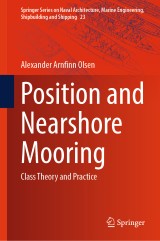Details

Position and Nearshore Mooring
Class Theory and PracticeSpringer Series on Naval Architecture, Marine Engineering, Shipbuilding and Shipping, Band 23
|
149,79 € |
|
| Verlag: | Springer |
| Format: | |
| Veröffentl.: | 20.07.2024 |
| ISBN/EAN: | 9783031656750 |
| Sprache: | englisch |
| Anzahl Seiten: | 200 |
Dieses eBook enthält ein Wasserzeichen.
Beschreibungen
<p>This book provides a summary of the Class Rules and Guides for mooring systems so that they are easier to navigate and therefore implement.</p>
<p>Mooring systems have been evolving in design, analysis, operating management, and other areas to meet the challenges of safety and efficiency. To ensure these challenges are met, Class Rules and Guides are developed and updated to keep pace with the maritime industry. This has resulted in a complex library of Class Rules and Guides. Many requirements are repeated throughout these Class Rules and Guides making use and maintenance of Class Rules/Guides increasingly cumbersome and bureaucratic.</p>
<p>In addition to the consolidation of the current requirements, this book also includes guidance in the following areas based on the latest industry knowledge and experiences:</p>
<ul>
<li>Vortex-Induced Motion (VIM) effect.</li>
<li>Bending-tension fatigue of mooring chains.</li>
<li>Fiber rope mooring criteria.</li>
<li>Mooring systems in squalls.</li>
<li>Dynamically installed anchors.</li>
<li>Anchor holding capacity.</li>
<li>Mooring analysis methodology.</li>
<li>Thruster-assisted mooring.</li>
</ul>
<p>Mooring systems have been evolving in design, analysis, operating management, and other areas to meet the challenges of safety and efficiency. To ensure these challenges are met, Class Rules and Guides are developed and updated to keep pace with the maritime industry. This has resulted in a complex library of Class Rules and Guides. Many requirements are repeated throughout these Class Rules and Guides making use and maintenance of Class Rules/Guides increasingly cumbersome and bureaucratic.</p>
<p>In addition to the consolidation of the current requirements, this book also includes guidance in the following areas based on the latest industry knowledge and experiences:</p>
<ul>
<li>Vortex-Induced Motion (VIM) effect.</li>
<li>Bending-tension fatigue of mooring chains.</li>
<li>Fiber rope mooring criteria.</li>
<li>Mooring systems in squalls.</li>
<li>Dynamically installed anchors.</li>
<li>Anchor holding capacity.</li>
<li>Mooring analysis methodology.</li>
<li>Thruster-assisted mooring.</li>
</ul>
<p>Chapter 1. Classification of Mooring Systems.- Chapter 2. Mooring System Design.- Chapter 3. Thruster Assisted Mooring.- Chapter 4. Pre-laid station keeping systems for mobile offshore units.- Chapter 5. Mooring System Components.- Chapter 6. Mooring System Analysis.- Chapter 7. Available Thrust Analysis.- Chapter 8. Vortex Induced Movement (VIM).- Chapter 9. Mooring Chain Fatigue.- Chapter 10. Nearside Position Mooring.- Chapter 11. Nearside Mooring Design Considerations.- Chapter 12. Sample Jetty Mooring Analysis.- Chapter 13. Mooring Integrity Analysis.- Chapter 14. Baseline Condition of Existing Mooring Systems.- Chapter 15. Mooring Integrity Assessment.- Chapter 16. Example of Mooring System Life Extension.- Glossary.- References.</p>
<p>Alexander is a Training Solutions Architect for a leading UK maritime engineering and defence company. Formerly a senior consultant for the Italian Shipping Registry, RINA SpA, Alexander has developed a breadth of experience across marine training development, design, and delivery. This book is intended as a reference for marine professionals and students with an interest in position and nearside mooring theory and practice.</p>
<p>This book provides a summary of the Class Rules and Guides for mooring systems so that they are easier to navigate and therefore implement.</p>
<p>Mooring systems have been evolving in design, analysis, operating management, and other areas to meet the challenges of safety and efficiency. To ensure these challenges are met, Class Rules and Guides are developed and updated to keep pace with the maritime industry. This has resulted in a complex library of Class Rules and Guides. Many requirements are repeated throughout these Class Rules and Guides making use and maintenance of Class Rules/Guides increasingly cumbersome and bureaucratic.</p>
<p>In addition to the consolidation of the current requirements, this book also includes guidance in the following areas based on the latest industry knowledge and experiences:</p>
<ul>
<li>Vortex-Induced Motion (VIM) effect.</li>
<li>Bending-tension fatigue of mooring chains.</li>
<li>Fiber rope mooring criteria.</li>
<li>Mooring systems in squalls.</li>
<li>Dynamically installed anchors.</li>
<li>Anchor holding capacity.</li>
<li>Mooring analysis methodology.</li>
<li>Thruster-assisted mooring.</li>
</ul>
<p>Mooring systems have been evolving in design, analysis, operating management, and other areas to meet the challenges of safety and efficiency. To ensure these challenges are met, Class Rules and Guides are developed and updated to keep pace with the maritime industry. This has resulted in a complex library of Class Rules and Guides. Many requirements are repeated throughout these Class Rules and Guides making use and maintenance of Class Rules/Guides increasingly cumbersome and bureaucratic.</p>
<p>In addition to the consolidation of the current requirements, this book also includes guidance in the following areas based on the latest industry knowledge and experiences:</p>
<ul>
<li>Vortex-Induced Motion (VIM) effect.</li>
<li>Bending-tension fatigue of mooring chains.</li>
<li>Fiber rope mooring criteria.</li>
<li>Mooring systems in squalls.</li>
<li>Dynamically installed anchors.</li>
<li>Anchor holding capacity.</li>
<li>Mooring analysis methodology.</li>
<li>Thruster-assisted mooring.</li>
</ul>
Consolidates the latest Classification requirements for position and nearside mooring systems Includes guidance based on the latest industry knowledge and experience A reference for academics and students in naval architecture, design and engineering, and professionals
Diese Produkte könnten Sie auch interessieren:

Neutron Applications in Earth, Energy and Environmental Sciences

von: Liyuan Liang, Romano Rinaldi, Helmut Schober

149,79 €

Nanobioelectronics - for Electronics, Biology, and Medicine

von: Andreas Offenhäusser, Ross Rinaldi

96,29 €














